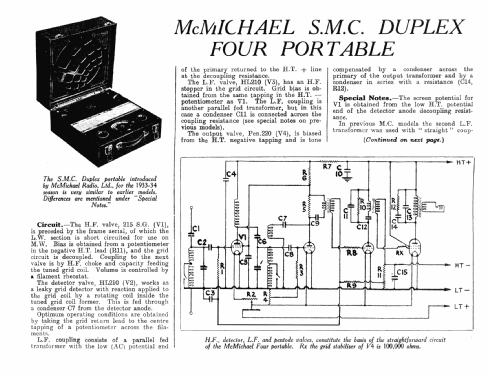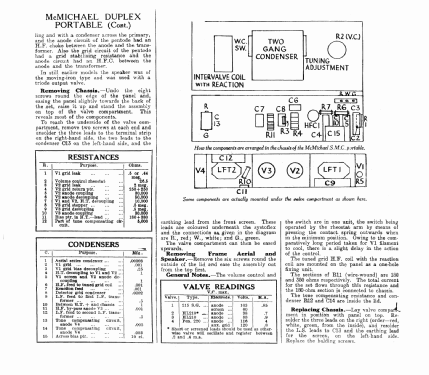Duplex four SMC early
McMichael Radio Ltd.; Slough
- Land
- Grossbritannien (UK)
- Hersteller / Marke
- McMichael Radio Ltd.; Slough
- Jahr
- 1933/1934
- Kategorie
- Rundfunkempfänger (Radio - oder Tuner nach WW2)
- Radiomuseum.org ID
- 178620
-
- anderer Name: McMichael, Leslie
Klicken Sie auf den Schaltplanausschnitt, um diesen kostenlos als Dokument anzufordern.
- Anzahl Röhren
- 4
- Hauptprinzip
- Geradeaus oder Audion mit Rückkopplung; 2 NF-Stufe(n)
- Anzahl Kreise
- 2 Kreis(e) AM
- Wellenbereiche
- Langwelle, Mittelwelle (LW+MW).
- Betriebsart / Volt
- Akku und/oder Batterie / 2 & 126 Volt
- Lautsprecher
- Dynamischer LS, keine Erregerspule (permanentdynamisch) / Ø 5 inch = 12.7 cm
- Belastbarkeit / Leistung
- 0.3 W (Qualität unbekannt)
- Material
- Leder / Stoff / Plastic / Segeltuch über div. Material
- von Radiomuseum.org
- Modell: Duplex four SMC [early] - McMichael Radio Ltd.; Slough
- Form
- Reisegerät > 20 cm (netzunabhängig betreibbar)
- Abmessungen (BHT)
- 390 x 220 x 380 mm / 15.4 x 8.7 x 15 inch
- Bemerkung
- The early model SMC has a manual volume control by means of a variable filament current for the RF stage, while the late model used to vary the RF stage grid bias.
This is a leathercovered suitcase model. The lid of the case contains the frame aerial and the loudspeaker.
- Nettogewicht
- 13 kg / 28 lb 10.1 oz (28.634 lb)
- Literaturnachweis
- Radio! Radio! (p.127, fig.368)
- Literatur/Schema (1)
- Hardware analysis.
- Autor
- Modellseite von Konrad Birkner † 12.08.2014 angelegt. Siehe bei "Änderungsvorschlag" für weitere Mitarbeit.
- Weitere Modelle
-
Hier finden Sie 183 Modelle, davon 123 mit Bildern und 120 mit Schaltbildern.
Alle gelisteten Radios usw. von McMichael Radio Ltd.; Slough
Forumsbeiträge zum Modell: McMichael Radio Ltd.: Duplex four SMC
Threads: 1 | Posts: 1
There is an early version applying manual gain control by means of filament variation in the RF stage.
This was state of the art for battery triodes in the late 1920's.
But now the RF triode was replaced by a superior screen grid valve. Such a valve is behaving different to filament variations, in particular at low emission for low gain, where the setting is rather unstable.
Obviously led this drawback to a redesign of the volume control by leaving the filament on full supply while a variable grid bias was introduced. This results in an easier and smoother control function.
The available documentation describes the late version only.
The early version was on my workbench for repair. It had a low resistance rheostat (original, physically identical with the high resistance potentiometer in the late version) but some "repair" attempts of previous owners left a chaos: senseless resoldered wires, wrongly connected on-off-switch etc.
He must have desperately decided to sell the spoiled thing after replacing two original Audios by defect ones (different brands; all 4 windings open), putting four valves with open filament. The next owner (in Germany) could not do much better and sold it again.
Now the buyer asked me for help.
I can proudly report that the radio is back to life now (after spending about 3 days to navigate through the wiring jungle and the wrong map (schematic)...
Konrad Birkner † 12.08.2014, 20.Jul.10

